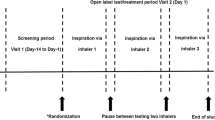Abstract
Patients with chronic obstructive pulmonary disease (COPD) often subjectively benefit from inhaled R2-agonists in spite of little or no demonstrable effect in forced expiratory volume in 1 second (FEV1.0). A comparison between the effects of terbutaline administered via a dry powder inhaler (Turbuhaler®) and via a chlorofluorocarbon (CFC) inhaler in conjunction with a spacer device (Nebuhaler®) was performed in patients with regard to FEV1.0, forced expiratory capacity (FVC), residual volume (RV), and specific conductance (s-Gaw). Fifteen hospitalised patients (11 male) with COPD were studied, each of whom had a diurnal variation in peak expiratory flow (PEF) not exceeding 15% and with a demonstrated volume response to inhaled β2-agonists in FVC and/or RV of at least 15%. Patients were administered each of the following five treatments on a single occasion in a randomized order (latin square) in intervals of at least 2 days: placebo, terbutaline via Turbuhaler (1.0 and 2.5 mg) and terbutaline via a CFC inhaler (1.0 mg without and 2.5 mg with Nebuhaler). Inhalation of terbutaline in different doses and from different devices induced a decrease in RV, an increase in FVC, and s-Gaw and a less pronounced increase in FEV1.0. No statistically significant differences between the four terbutaline treatments were seen, but all were significantly different from the placebo. These findings indicate that while patients with COPD may benefit from inhaled terbutaline through decreased hyperinflation, the choice of inhalation device seems to be of little importance for its efficacy.
Similar content being viewed by others
References
American Thoracic Society (1987) Standards for the diagnosis and care of patients with chronic obstructive pulmonary disease (COPD) and asthma. Am Rev Respir Dis 136:225–244
Bellamy D, Hutchison DCS (1981) The effects of salbutamol aerosol on lung function in patients with pulmonary emphysema. Br J Dis Chest 75:190–196
Dompeling E, van Schayck CP, Molema J, Akkermans R, Folgering H, van Grunsven PM, van Weel C (1992) A comparison of six different ways of expressing the bronchodilating response in asthma and COPD; reproducibility and dependence of pre-bronchodilator FEV1.0 Eur Respir J 5:975–981
Eliasson O, De Graff AC (1985) The use of criteria for reversibility and obstruction to define patient groups for bronchodilator trials: Influence of clinical diagnosis, spirometric and anthropometric variables. Am Rev Respir Dis 132:858–864
Flenley DC (1988) Chronic obstructive pulmonary disease. Dis Mon 34:543–599
International Consensus Report on Diagnosis and Management of Asthma Bethesda MD: National Heart, Lung and Blood Institute (1992) US Dept of Health and Human Services publication 92-3091
Macklem PT (1984) Hyperinflation, Editorial. Am Rev Respir Dis 129:1–2
Newman SP, Millar AB, Lennard-Jones TR, Morén F, Clarke SW (1984) Improvement of pressurized aerosol disposition with Nebuhaler Spacer device. Thorax 39:935–941
Report of the committee on emphysema (American College of Chest Physician, G. Snider Chairman) (1974). Criteria for the assessment of reversibility in airways obstruction. Chest 65:552–553
Wetterlin K (1988) A new powder inhaler for administration of drugs to the airways. Pharm Res 5(8):506–508
Author information
Authors and Affiliations
Rights and permissions
About this article
Cite this article
Formgren, H., Sjökvist, Å., Ståhl, E. et al. Terbutaline in COPD comparison between turbuhaler® and chlorofluorocarbon (CFC) inhaler. Lung 172, 271–280 (1994). https://doi.org/10.1007/BF00164309
Accepted:
Issue Date:
DOI: https://doi.org/10.1007/BF00164309




